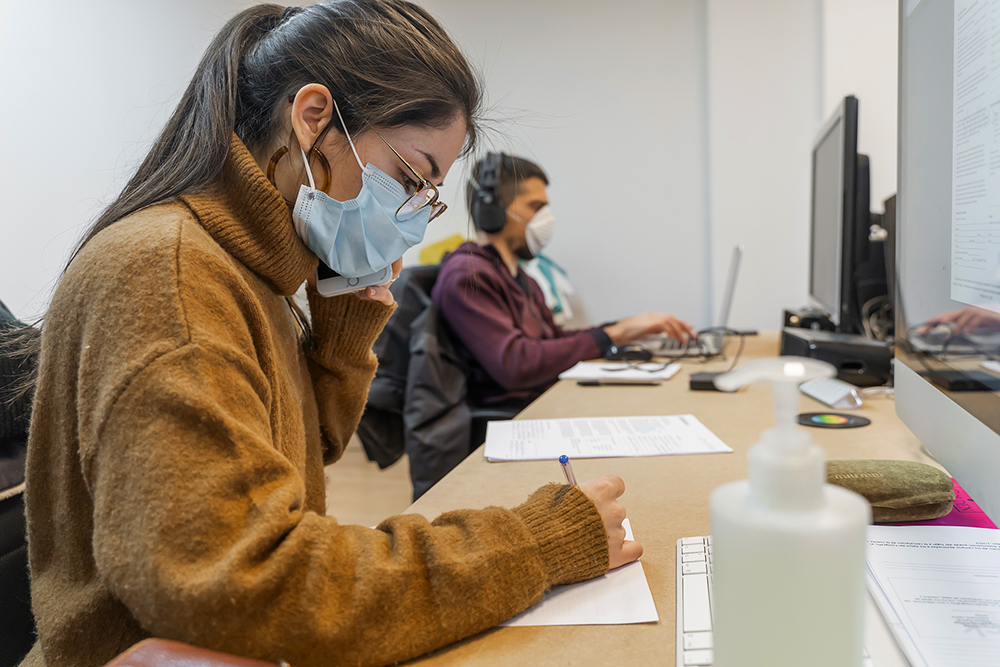After a semester of online learning and a summer of physical distancing, most college students are ready, willing and possibly able to return for the fall semester. A poll by College Reaction/Axios found 76% of students plan to return to campus if their schools give them the option. Sixty-six percent would attend in-person classes if they were available.
College administrators are making decisions so students can return. According to The Chronicle of Higher Education, 57% of schools plan to hold in-person fall classes and 29% have proposed a hybrid model of in-person and online instruction. Syracuse University, for example, is introducing an alternating schedule with half of students attending class in-person one day with the other half online, then switching segments the next day.
Housing is also a consideration. George Mason University reduced housing by 25% to limit the number of students in high-density spaces and increase the number of single dorm rooms. Duke University is offering extra housing in local hotels and apartments to make sure students are able to have single rooms.
Whether you are a seasoned upperclassman or a first-time freshman, the campus rules have changed because of the pandemic. Parents and students will need a coronavirus safety checklist for the fall semester.
Return To Campus
Face Coverings
A mask is a college student’s front-line protection anywhere on campus: dorm, quad, cafeteria, classroom, study group. A recent study by researchers at UC Davis found physical distancing and wearing masks decreased the risk of infection by 65%.
Students will need a minimum of two masks a day and anywhere from 10-14 maximum for a week, depending on your living situation and lifestyle.
Take into account your access to laundry facilities. You may only use the laundry room weekly, or at an allotted time. You’ll want enough masks to get you through a week, unless you’re okay with washing a mask daily by hand and wearing the back up while it dries.
Travel Disinfectant Kit
Add two items to a backpack or purse: hand sanitizer (at least 60% alcohol) and bleach-based or hydrogen-peroxide based disinfectant wipes. Campuses may have these items available in high-traffic areas, but you’ll want your own stash in case you have to touch a questionable surface in a public area.
A study published by the Journal of Occupational and Environmental Hygiene found people in public places touched common objects or surfaces 3.3 times per hour. Coronavirus droplets tend to linger on surfaces: 72 hours on plastic and steel, 24 hours on cardboard and four hours on copper.
The disinfectant kit isn’t just for places you touch with your hands. You’ll want to be careful where you place your phone and backpack. Be sure to wipe down any shared surfaces like door knobs, cabinet handles, faucets, books, keypads, desks and chairs. The Centers for Disease Control and Prevention offers some back to college coronavirus safety tips.
10 Days Of Provisions
You never know when a classmate, teacher, roommate or neighbor could be diagnosed with COVID-19. Be prepared in case you need to stay home to self-isolate. Consider stocking up on basic items like toilet paper, pasta, cereal, canned goods and bottled water so you have enough to eat and drink without relying on others. If you don’t have a lot of space in your dorm, purchase energy bars, trail mixes and other items that provide a lot of nutritional value but don’t take up much room.
Cleaning Supplies
If you’re in quarantine, the janitorial staff may not be able to enter your room. Make sure you have your own cleaning supplies, such as disinfectant spray, paper towels, disposable gloves and plenty of hand soap.
First Aid Kit
Add a thermometer to your first aid kit. COVID-19 symptoms include shortness of breath, fever, coughing and a sore throat. A travel thermometer will help you keep tabs on your temperature.
If you are in the high-risk category for coronavirus due to underlying medical conditions, you’ll want to make sure your lungs are getting enough oxygen. A digital pulse oximeter, available at most pharmacies or online stores for less than $30, will track your real-time oxygen levels. It’s a simple device you place on your fingertip for less than a minute.
Drop Off Protocols
Online Safety Training
A return to higher education this fall will include continual education about coronavirus symptoms and a sound knowledge of health and safety measures. The University of Alabama at Birmingham requests students, faculty and staff complete a web-based safety and awareness course and complete a UAB Healthcheck, which is a COVID-19 assessment tool, before returning to campus. Georgia Tech asks students to complete a daily self-check list before coming to campus each day.
Solo Return
Sending a student to college used to be a family affair with parents and siblings packed in the car to help with the move. During the pandemic, drop off will be different, depending on the state the college is located. Washington, D.C. allows travel “to or through the district if it lasts less than 24 hours” so no lingering or multiple last-minute trips to local retailers. The University of North Carolina Chapel Hill plans to limit the number of people students can bring to help them, specifically asking all families to “leave as soon as is possible once all student belongings have been brought to their rooms.”
You may have to make an appointment to schedule your move into the dorm. Texas A&M University student move-ins will be conducted in phases with scheduled appointments. Parking may also only be available for an hour or less. These new procedures help limit the number of people on campus at any one time and reduce the risks of coronavirus contagion.
Coronavirus Testing
With students traveling to campus from all over the country, colleges may require a negative COVID-19 test three days before the first day of school.
Or students may tested upon their return to campus. The Montgomery Advertiser noted Alabama will spend a portion of its $1.9 billion federal coronavirus relief package to fund COVID-19 testing for students at public colleges in the state.
Then be prepared for multiple tests while on campus. Epidemic modeling by the Yale School of Public Health says one test might not be enough and students should be tested every two to three days. Lead researcher David Paltiel told U.S. News & World Report: “It’s just not possible to move swiftly enough to contain an outbreak using nothing more than symptom-based monitoring. You can’t play catch-up with this virus.”
The multiple testing strategy is one of many that colleges and universities are currently evaluating as they work toward campus reopening. The test does not need to be expensive or 100% sensitive, as rapid results are the key to preventing outbreaks.
Investigate Area Resources
It is research parents and students typically don’t do when selecting a college, but coronavirus has changed the norm. If a classmate or professor tests positive for coronavirus, college students will need to be familiar with their campus and neighborhood health care resources.
You’ll want to know what campus health services can offer (screenings and self-isolation areas) versus what the closest hospitals in the area offer (COVID-19 testing and isolation wards). Ask during drop-off day, if you haven’t already.|
Planning For Campus Life
You are coronavirus negative, settled in and ready to learn. Most of what students will see on campus are the same social distancing protocols practices at home: desks are six feet apart in the classroom and hallways are one-way. Some things will be different and that’s when a travel protection services membership or TotalCareSM membership can provide critical resources as well as peace of mind for concerned parents.
Travel Protection Services
Students are typically located 100 miles or more away from home, qualifying them for a travel protection services membership.
Students can access Global Rescue intelligence, which includes state-by-state and city-by-city restrictions, quarantines and hotspots in all 50 states and more than 200 countries worldwide. Global Rescue experts can answer coronavirus related questions and provide immediate information regarding appropriate nearby health care facilities.
If a medical evacuation is needed, Global Rescue can provide services to transport members to their home hospital of choice.
Telehealth Access
TotalCare memberships offer the same services as travel memberships — plus access to urgent care telemedicine services that students can utilize anywhere.
“TotalCare brings the doctor’s office to your dorm room, providing real-time medical access whenever and wherever you need it,” said David Koo, senior manager of operations at Global Rescue.
Your request is answered by an in-house Global Rescue operations team member and then you will be placed into a live video conference with a board certified, licensed doctor from Elite Medical Group (EMG).
TotalCare allows the member to have a direct interaction with a physician.
“With travel services, there’s no direct interaction between the member and the physician,” said Dr. Claudia Zegans, medical director. “With TotalCare, the member can get on video with one of the TotalCare physicians. It provides a higher degree of diagnosis because telehealth doctors can conduct physical exams.”









